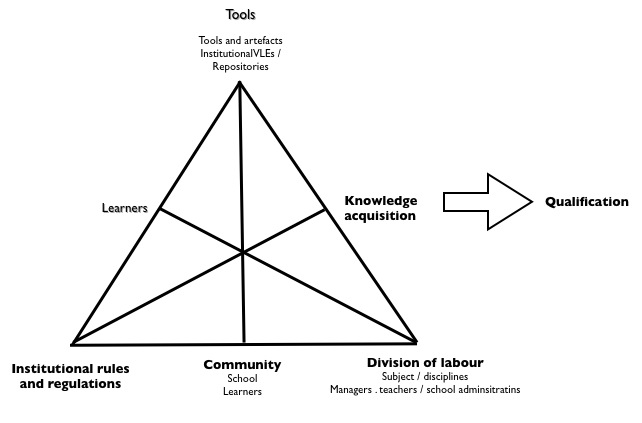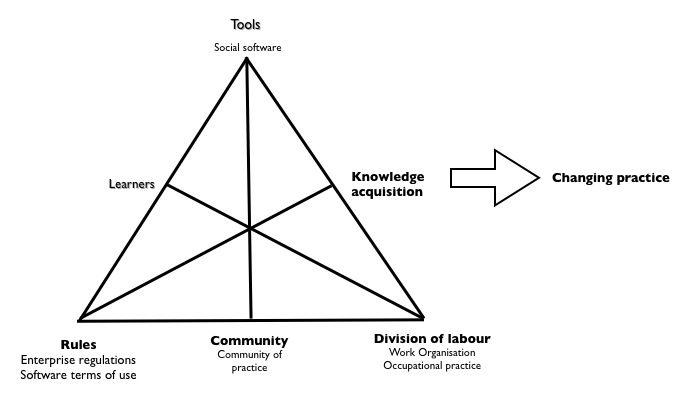One frequent comment I get from teachers when talking about the use of new technologies for learning is the need for examples of effective use in practice. And all too many projects, national and European, talk about changing practice but from a research or theoretical perspective.
The ICONET project has taken a different route. Based on the earlier ICOVET work, it sought to take a basic tool for identifying and recognising informal learning with socially disadvantaged young people, and implement it in different situations with different groups of learners. In the UK we worked in two quite different contexts, although both were located at Salford University. The first, called Cartoon Planet and working with Salford Young People’s University, has already been published on this blog.
The second sought to embed the process within a Personal Development through Enterprise initiative. In this report Helen Keegan explains the background and results of the project work.
Background
“The University of Salford is a Widening Participation university, with a student body largely made up of ‘first generation’ students – that is, students who are the first in their family to enter higher education. For many of our students, studying for a degree is particularly challenging. Students often fail to see the bigger picture in terms of the acquisition of invaluable life-skills, preferring instead to take an assessment-driven approach where formal learning is prized (i.e. what needs to be remembered/prepared in order to pass a module) at the expense of informal learning and skills development. However, in terms of pedagogy and public policy it is increasingly acknowledged that informal skills are equally as important (if not more so) than formally learnt curricula through the course of one’s life, where participation in a rapidly changing, networked society demands significant informal competencies which lie outside of mainstream curricula.
Finding ways of developing learners’ informal competencies alongside subject specific knowledge within mainstream curricula is therefore crucial. The Personal Development through Enterprise initiative focuses on developing informal competencies alongside Enterprise within the curriculum, through nurturing reflective practice on learning that goes on outside the classroom, alongside a core suite of 21st century competencies which are recognised as being essential attributes for the successful lifelong learner. Ultimately we want to equip our learners with the skills to self-direct their learning for life, through a process of meta-learning, critical reflection, and the ability to recognise their informal skills and how these enable them to become lifelong learners.
Development
Personal Development through Enterprise focuses on the development of innovative learning activities and teaching and mentoring methodologies as to foster the development of informal competencies and reflective skills alongside formal Enterprise curricula.
Over many years teaching in the classroom, the tutor had noticed how students appreciated being asked about what they do OUTSIDE the classroom – that is, their interests and activities in their spare time. Many of these activities have real value, and yet the students don’t think of their informal learning as being valuable as it is not being assessed. The aim was to recognise what people do outside the classroom, getting the students thinking about how the skills developed through their off-campus interests can be used across different contexts – valuing their informal learning alongside formal, and integrate the two.
Alongside this was the problem of the student’s perception of Enterprise in the curriculum. While entrepreneurial skills (and even more so, INTRAPRENEURIAL) are commonly seen as being essential skills in the workplace (the ability to lead, make decisions, and drive change from within), many students are resistant to the idea of Enterprise teaching as they see it as something which is only relevant to those who want to start their own business. This is a common misconception, but one which needs to be addressed and the skills required for Entrepreneurship are required in nearly all walks of life.
Piloting the programme
In order to engage the learners, encouraging them to reflect on their informal learning and how this leads to a set of behaviours which are transferrable across contexts – including organisational – we wanted to address the perceived lack of relevance of informal skill sets through active pedagogy and experiential learning rooted firmly in the real lives of our students, in order for them to realise their potential in the wider world as lifelong learners.
We wanted to make the classroom more dynamic, giving learners control in terms of how the sessions were run – and even what content they covered. There was a strong emphasis placed on peer mentoring.
The class were split into groups and each week a different group would lead the session. Suggested (and covered) topics were:
- Organising
- Leadership
- Working across cultures
- Assertion and negotiation
- Using broadcast materials for presenting
- Business ethics
Each group was only given a brief outline of the topic/goals for the session and they had to create the lesson themselves, sourcing information and using examples from their everyday lives and first-hand experiences.
They were asked to design classroom sessions which were fun and interactive – some of the things they came up with included games, debates, role-playing and even a song competition!
There was an emphasis on imaginative uses of technology to support their sessions and learning, e.g. wikis, videos, audio, visual aids and props. They were encouraged to use idea creation techniques such as brainstorming (both within groups for session planning and in the sessions they actually led). The students developed skills in using and managing information, particularly in the sense of synthesising their informal learning into what they commonly thought of as ‘learning’ (which tended to be formal). They communicated ideas to others using multiple forms of media and technology (which involved them developing a fundamental understanding of the ethical/legal issues surrounding the access and use of media), and reflected critically on their learning which helped them to develop the ability to self-direct their learning.
As in the case of Cristina Costa’s Cartoon Planet project (one of the other ICONET studies), the curriculum criteria were based on three broad aspects of teaching and learning:
- an interactive approach;
- a focus on informal learning and skills;
- attractive, diverse strategies for class engagement.
A learning development journal was kept by each student in order to stimulate individual, peer and group reflection, and this gave them a structure within which to translate their informal competences – gained within, but also (and more importantly) outside the classroom – into a ‘CV-ready’ format, enabling them to recognise the links between their informal learning and how this can be reported in a more formalised manner.
Results
As in the case of Cartoon Planet, the outcomes envisaged were:
- To stimulate guided reflection about the learners’ strengths and skills through different peer and group activities.
- To utilise Information and Communication Technologies (ICT) to empower students to communicate their skills and competences in an interactive and personally meaningful way.
However, in this case one of the most empowering aspects of the project was that students were given a brief which was wide open in terms of the way that they used ICT – obviously this is much easier to do when the students are older, as in this case. Through giving the students the opportunity to develop the content and design their own sessions (the main instructions being to base everything on their experiences OUTSIDE of the university and to use whatever ICT they wanted in innovative ways), the students became highly engaged and started to realise that the concepts, knowledge and transferrable skills which are covered in Enterprise teaching are in fact everyday skills which they have been practicing throughout their lives without actually realising it!
Issues around leadership and roles were viewed through the lens of friends and family, then teased out and viewed through the lens of the workplace. Issues around presenting using broadcast materials and business ethics were viewed through the lens of file sharing on the internet (of which many students have first hand experience).
Each group delivered a final presentation outlining ideas for a business which drew on their informal learning (i.e. hobbies outside of university) but informed by concepts covered in class, and they came up with some fantastic ideas based on their informal skills which they wouldn’t ordinarily bring into the classroom environment. By leading workshop sessions themselves they developed real confidence in their ability to stand up and express their ideas, and did so in an engaging and imaginative way.
The personal development journals were particularly effective not only for the recognition of competences, but for the identification of problematic areas (some students reflected on their difficulties with time-keeping and organisation which they had not picked up on before, purely because they hadn’t needed to direct their own learning and be responsible to a team to such a great extent). They developed valuable skills in reflecting on their own learning, both inside and outside the classroom, and how they influence one another.
Reflection
Feedback from the students indicated that they found their self-directed workshops to be of real value, although at first they were nervous about taking responsibility for their learning in this way. They also expressed surprise that so many of the skills they brought into the workshops were skills that they had developed outside of the classroom. Through being encouraged to work independently in groups, using a diverse range of media, they were able to develop a range of 21st century skills – particularly in terms of collaboration and creativity – based on their informal learning.
Something which worked particularly well was their final presentations, where they were asked to work in their groups and develop an idea for a business and present it without using Powerpoint. This meant that they came up with innovative ways to ‘sell’ their idea, such as panel games and role-playing. One group was made up of boating hobbyists and 2 environmental campaigners (all activities which they were involved in outside of the university), and so they came up with an idea to run water-taxis between Manchester City Centre and a new MediaCity development, cleaning up the waterways in the process. One month later there was an announcement in the local news that a water-taxi business is going ahead in the area – nearly identical to their idea! For them, to be able to bring in their informal learning and present it in a business-like way gave them a real sense of worth, and a genuine appreciation that they had been able to use their informal learning in a formal setting.
The personal development journals worked really well as they helped the learners to reflect and develop meta-skills needed for lifelong learning. Also, the PDJ gave the learners a method for the translation of informal competences into a more formal framework, which is especially useful when it comes to CV-writing.
Overall, the emphasis placed on their extra-curricula activities and ‘accidental’ learning allowed them to see themselves differently, recognising that they have valuable skills which haven’t been acquired formally and therefore valuing what goes on outside the classroom much more than they did before. In this sense, it was transformative.
In summary, the elements which really helped to engage the learners were:
- Facilitated independence in terms of group work
- Regular mentoring from the tutor (face-2-face)
- An environment where they felt free to take risks
- Socially-oriented learning
- Opportunities for creativity across a range of media
- An emphasis on peer interaction and collaboration
- A sense of fun and play”


